Potential of Cost-Efficient Single Frequency GNSS Receivers for Water Vapor Monitoring
Abstract
1. Introduction
2. Methodology
2.1. Water Vapor from GNSS Measurements
2.2. SEID Ionospheric Delay Modeling
2.3. Experimental Setup and Data Processing
3. Results
3.1. Inter-Comparison of Different ZTD Reference Datasets
3.2. SEID-PPP-Processed ZTD Estimations
3.3. PWV Computation
3.4. Splitting of A Geodetic Antenna to Different Receiver Types (Italy)
4. Discussion
4.1. Inter-Comparison of Reference Datasets and Analysis of the Software-Related Error
4.2. SEID DPGA Experiment and Antenna Impact
4.3. SEID EUREF Experiment
4.4. PWV Estimations
4.5. Antenna Splitting
5. Conclusions
Author Contributions
Funding
Acknowledgments
Conflicts of Interest
Abbreviations
| AC | Analysis Center |
| AWS | Automatic Weather Station |
| BKG | Federal Agency for Cartography and Geodesy |
| CDDIS | Crustal Dynamics Data Information System |
| COCONet | Continuously Operating Carribbean GPS Observational Network |
| DLF1_DF | IGS station DLF1 (dual-frequency) |
| DLF1_SF | IGS station DLF1 (single-frequency) |
| DPGA | Dutch Permanent GNSS Array |
| EGM08 | Earth Gravity Model 2008 |
| E-GVAP | EUMETNET GNSS water vapor Programme |
| EPN | EUREF Permanent Network |
| GFZ | German Research Centre for Geosciences |
| GMF | Global Mapping Function |
| GMU | GeoGuard Monitoring Unit |
| GNSS | Global Navigation Satellite System |
| GPS | Global Positioning System |
| GPT | Global Pressure/Temperature |
| IGS | International GNSS Service |
| IP | Ingress Protection |
| IPP | Ionospheric Pierce Point |
| IWV | Integrated Water Vapor |
| KNMI | Royal Netherlands Meteorological Institute |
| LPT | Federal Office of Topography |
| NGL | Nevada Geodetic Laboratory |
| NRT | Near-Real Time |
| PPP | Precise Point Positioning |
| PWV | Precipitable Water Vapor |
| RF | Radio Frequency |
| RINEX | Receiver Independent Exchange Format |
| RMSE | Root Mean Square Error |
| ROB | Royal Observatory of Belgium |
| RTK | Real-Time Kinematic |
| SEID | Satellite-specific and Epoch-differenced Ionospheric Delay |
| STD | Slant Total Delay |
| teqc | translation, editing and quality check |
| UBX | u-blox NEO-M8T evaluation toolkit |
| ZHD | Zenith Hydrostatic Delay |
| ZTD | Zenith Tropospheric Delay |
| ZWD | Zenith Wet Delay |
References
- Kiehl, J.T.; Trenberth, K.E. Earth’s Annual Global Mean Energy Budget. Bull. Am. Meteorol. Soc. 1997, 78, 197–208. [Google Scholar] [CrossRef]
- Andrews, D. An Introduction to Atmospheric Physics; International Geophysics Series; Cambridge University Press: Cambridge, UK, 2000. [Google Scholar]
- Seko, H.; Nakamura, H.; Shoji, Y.; Iwabuchi, T. The meso-y scale water vapor distribution associated with a thunderstorm calculated from a dense network of GPS receivers. JMSJ 2004, 82, 569–586. [Google Scholar] [CrossRef]
- Cess, R.D.; Potter, G.L.; Blanchet, J.P.; Boer, G.J.; Del Genio, A.D.; Déqué, M.; Dymnikov, V.; Galin, V.; Gates, W.L.; Ghan, S.J.; et al. Intercomparison and interpretation of climate feedback processes in 19 atmospheric general circulation models. J. Geophys. Res. Atmos. 1990, 95, 16601–16615. [Google Scholar] [CrossRef]
- Ning, T.; Wang, J.; Elgered, G.; Dick, G.; Wickert, J.; Bradke, M.; Sommer, M.; Querel, R.; Smale, D. The uncertainty of the atmospheric integrated water vapour estimated from GNSS observations. Atmos. Meas. Tech. 2016, 9, 79. [Google Scholar] [CrossRef]
- Kuo, Y.H.; Zou, X.; Guo, Y.R. Variational assimilation of precipitable water using a nonhydrostatic mesoscale adjoint model. Part I: Moisture retrieval and sensitivity experiments. Mon. Weather Rev. 1996, 124, 122–147. [Google Scholar] [CrossRef]
- Sato, K.; Realini, E.; Tsuda, T.; Oigawa, M.; Iwaki, Y.; Shoji, Y.; Seko, H. A high-resolution, precipitable water vapor monitoring system using a dense network of GNSS receivers. J. Dis. Res. 2013, 8, 37–47. [Google Scholar] [CrossRef]
- Realini, E.; Sato, K.; Tsuda, T.; Oigawa, M.; Iwaki, Y.; Shoji, Y.; Seko, H. Local-scale Precipitable Water Vapor Retrieval from High-Elevation Slant Tropospheric Delays Using A Dense Network of GNSS Receivers. In IAG 150 Years. International Association of Geodesy Symposia; Rizos, C., Willis, P., Eds.; Springer: Cham, Switzerland, 2015; Volume 143, pp. 485–490. [Google Scholar]
- GNSS Earth Observation Network System. Available online: http://datahouse1.gsi.go.jp/terras/terras_english.html (accessed on 12 September 2018).
- Oigawa, M.; Tsuda, T.; Seko, H.; Shoji, Y.; Realini, E. Data assimilation experiment of precipitable water vapor observed by a hyper-dense GNSS receiver network using a nested NHM-LETKF system. Earth Planets Space 2018, 70, 74. [Google Scholar] [CrossRef]
- Baldysz, Z.; Nykiel, G.; Figurski, M.; Araszkiewicz, A. Assessment of the Impact of GNSS Processing Strategies on the Long-Term Parameters of 20 Years IWV Time Series. Remote Sens. 2018, 10, 496. [Google Scholar] [CrossRef]
- Deng, Z.; Bender, M.; Dick, G.; Ge, M.; Wickert, J.; Ramatschi, M.; Zou, X. Retrieving tropospheric delays from GPS networks densified with single frequency receivers. Geophys. Res. Lett. 2009, 36. [Google Scholar] [CrossRef]
- Zumberge, J.; Heflin, M.; Jefferson, D.; Watkins, M.; Webb, F. Precise point positioning for the efficient and robust analysis of GPS data from large networks. J. Geophys. Res. B Solid Earth 1997, 102, 5005–5017. [Google Scholar] [CrossRef]
- Deng, Z.; Bender, M.; Zus, F.; Ge, M.; Dick, G.; Ramatschi, M.; Wickert, J.; Lhnert, U.; Schön, S. Validation of tropospheric slant path delays derived from single and dual frequency GPS receivers. Radio Sci. 2011, 46, 1–11. [Google Scholar] [CrossRef]
- GeoGuard Earth Monitoring Services. Available online: http://www.geoguard.eu/ (accessed on 16 May 2018).
- Thayer, G. An improved equation for the radio refractive index of air. Radio Sci. 1974, 9, 803–807. [Google Scholar] [CrossRef]
- Saastamoinen, J. Contributions to the theory of atmospheric refraction. Bull. Geod. 1972, 46, 279–298. [Google Scholar] [CrossRef]
- Bevis, M.; Businger, S.; Herring, T.A.; Rocken, C.; Anthes, R.A.; Ware, R.H. GPS meteorology: Remote sensing of atmospheric water vapor using the global positioning system. J. Geophys. Res. Atmos. 1992, 97, 15787–15801. [Google Scholar] [CrossRef]
- Baltink, H.K.; Van Der Marel, H.; van der Hoeven, A.G. Integrated atmospheric water vapor estimates from a regional GPS network. J. Geophys. Res. Atmos. 2002, 107. [Google Scholar] [CrossRef]
- Bevis, M. GPS meteorology: Mapping zenith wet delays onto precipitable water. J. Appl. Meteorol. 1994, 33, 379–386. [Google Scholar] [CrossRef]
- Pavlis, N.K.; Holmes, S.A.; Kenyon, S.C.; Factor, J.K. An earth gravitational model to degree 2160: EGM2008. EGU Gener. Assem. 2008, 10, 13–18. [Google Scholar]
- Berberan-Santos, M.N.; Bodunov, E.N.; Pogliani, L. On the barometric formula. Am. J. Phys. 1997, 65, 404–412. [Google Scholar] [CrossRef]
- Schaer, S. Mapping and predicting the Earth’s ionosphere using the Global Positioning System. Geod. Geophys. Arb. Schweiz 1999, 59. [Google Scholar]
- Araujo-Pradere, E.; Fuller-Rowell, T.; Spencer, P.; Minter, C. Differential validation of the US-TEC model. Radio Sci. 2007, 42, RS3016. [Google Scholar] [CrossRef]
- Estey, L.H.; Meertens, C.M. TEQC: The Multi-Purpose Toolkit for GPS/GLONASS Data. GPS Solut. 1999, 3, 42–49. [Google Scholar] [CrossRef]
- Herrera, A.M.; Suhandri, H.F.; Realini, E.; Reguzzoni, M.; de Lacy, M.C. goGPS: Open-source MATLAB software. GPS Solut. 2016, 20, 595–603. [Google Scholar] [CrossRef]
- Lyard, F.; Lefevre, F.; Letellier, T.; Francis, O. Modelling the global ocean tides: Modern insights from FES2004. Ocean. Dynam. 2006, 56, 394–415. [Google Scholar] [CrossRef]
- Dow, J.; Neilan, R.; Rizos, C. The International GNSS Service in a changing landscape of Global Navigation Satellite Systems. J. Geod. 2009, 83, 191–198. [Google Scholar] [CrossRef]
- Noll, C.E. The Crustal Dynamics Data Information System: A resource to support scientific analysis using space geodesy. Adv. Space Res. 2010, 45, 1421–1440. [Google Scholar] [CrossRef]
- Blewitt, G. FTP Archive of NGL Troposphere Delay Products. Available online: ftp://gneiss.nbmg.unr.edu/trop (accessed on 16 May 2018).
- EUREF Permanent GNSS Network. Available online: http://epncb.eu/_productsservices/troposphere/ (accessed on 16 May 2018).
- de Haan, S. National/Regional Operational Procedures of GPS Water Vapour Networks and Agreed International Procedures; Rep WMO/TD-No. 1340; World Meteorological Organization: Geneva, Switzerland, 2006. [Google Scholar]
- Topcon Positioning Italy. Available online: http://www.netgeo.it/ (accessed on 28 May 2018).
- Pesyna, K.M.J.; Robert, W.H.J.; Humphreys, T.E. Centimeter positioning with a smartphone-quality GNSS antenna. In Proceedings of the ION GNSS+ Meeting, Tampa, FL, USA, 8–12 September 2014. [Google Scholar]
- Jiang, P.; Ye, S.; Chen, D.; Liu, Y.; Xia, P. Retrieving precipitable water vapor data using GPS zenith delays and global reanalysis data in China. Remote Sens. 2016, 8, 389. [Google Scholar] [CrossRef]
- Adams, D.K.; Fernandes, R.M.; Kursinski, E.R.; Maia, J.M.; Sapucci, L.F.; Machado, L.A.; Vitorello, I.; Monico, J.F.G.; Holub, K.L.; Gutman, S.I.; et al. A dense GNSS meteorological network for observing deep convection in the Amazon. Atmos. Sci. Lett. 2011, 12, 207–212. [Google Scholar] [CrossRef]
- Barindelli, S.; Realini, E.; Venuti, G.; Fermi, A.; Gatti, A. Detection of water vapor time variations associated with heavy rain in northern Italy by geodetic and low-cost GNSS receivers. Earth Planets Space 2018, 70, 28. [Google Scholar] [CrossRef]
- Transforming Weather Water Data into Value-Added Information services for Sustainable Growth in Africa. Available online: http://twiga-h2020.eu/ (accessed on 12 September 2018).
- Dong, Z.; Jin, S. 3-D Water Vapor Tomography in Wuhan from GPS, BDS and GLONASS Observations. Remote Sens. 2018, 10, 62. [Google Scholar] [CrossRef]
- Lu, C.; Chen, X.; Liu, G.; Dick, G.; Wickert, J.; Jiang, X.; Zheng, K.; Schuh, H. Real-Time Tropospheric Delays Retrieved from Multi-GNSS Observations and IGS Real-Time Product Streams. Remote Sens. 2017, 9, 1317. [Google Scholar] [CrossRef]
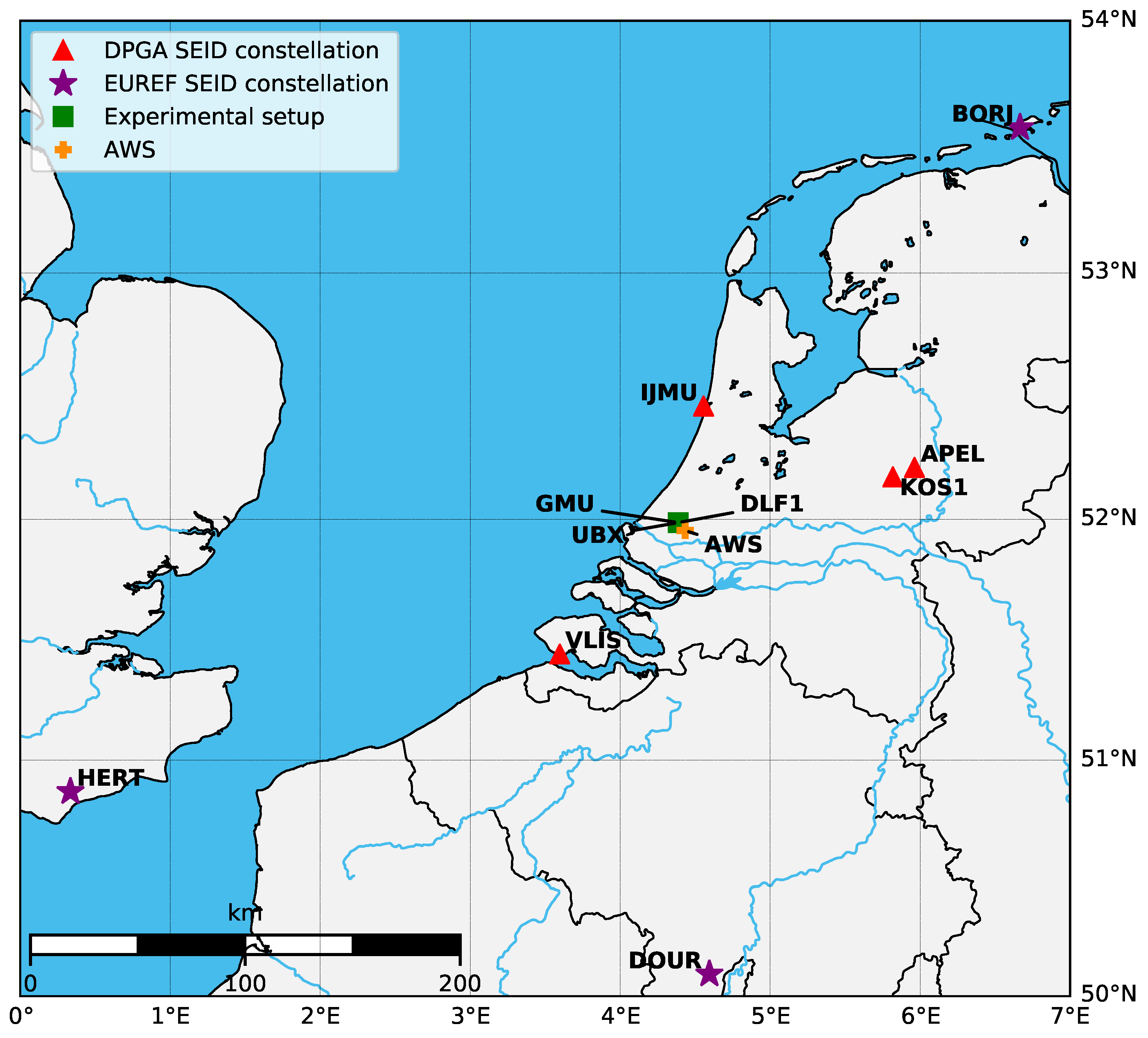
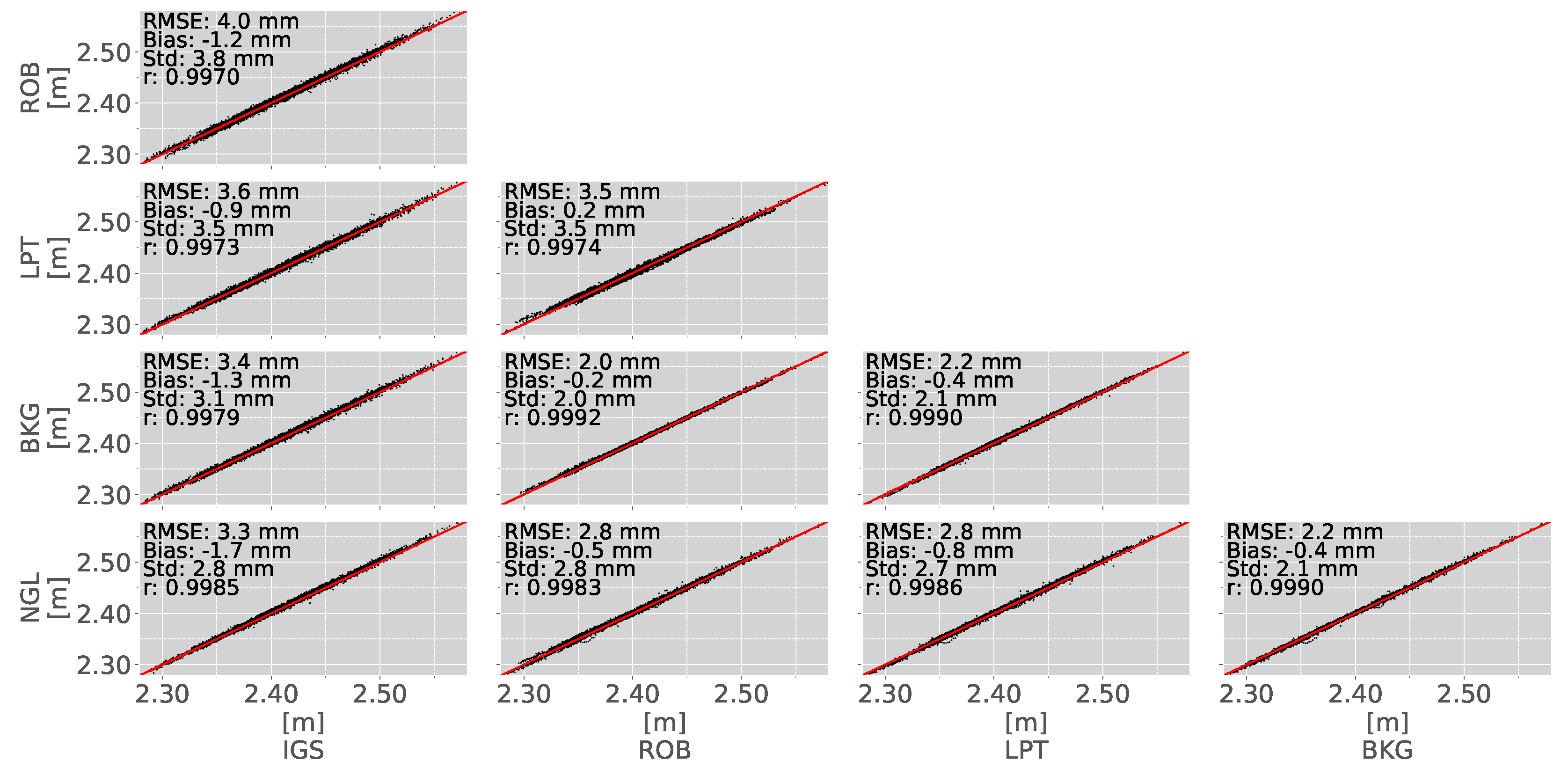
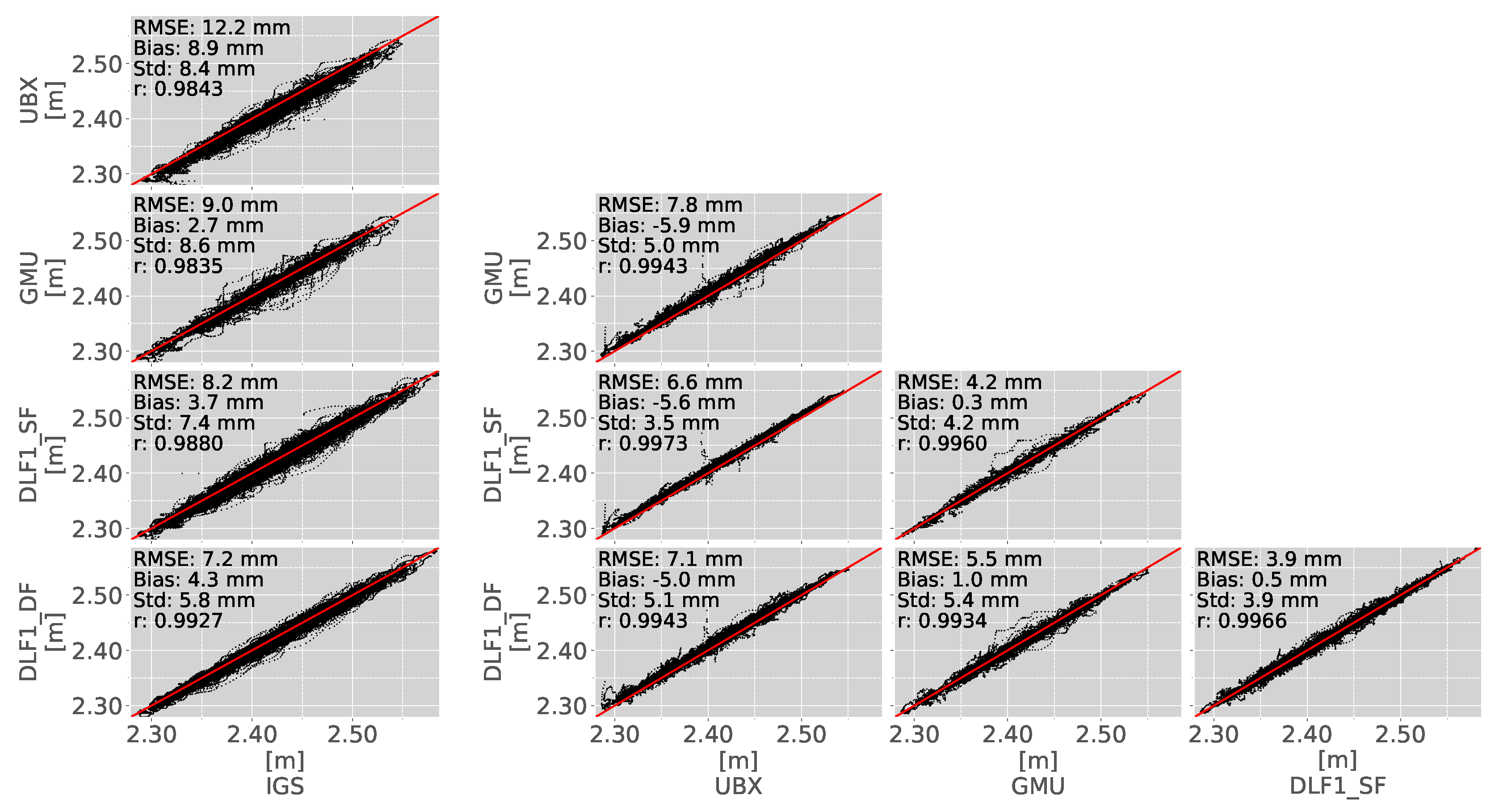
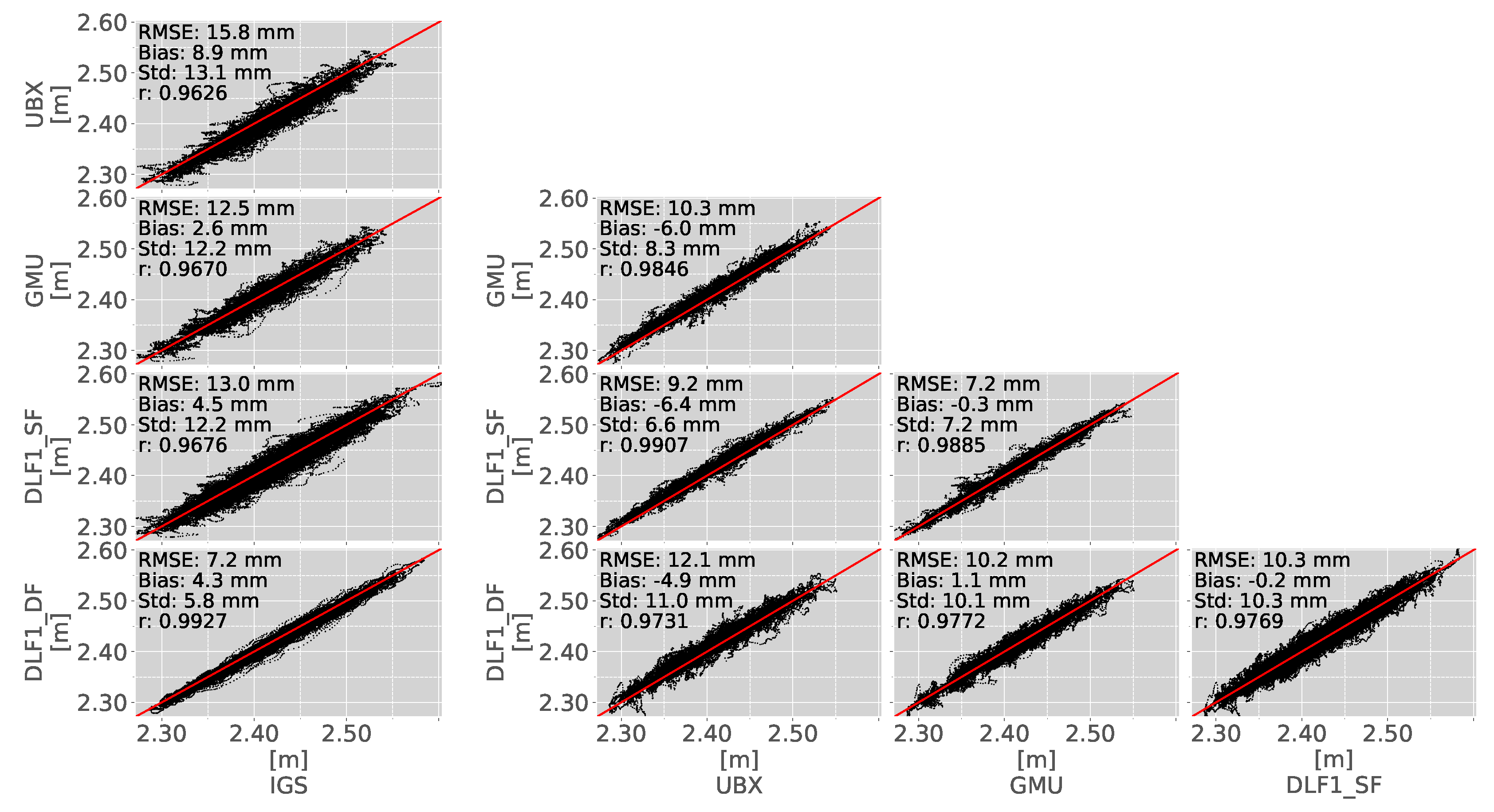
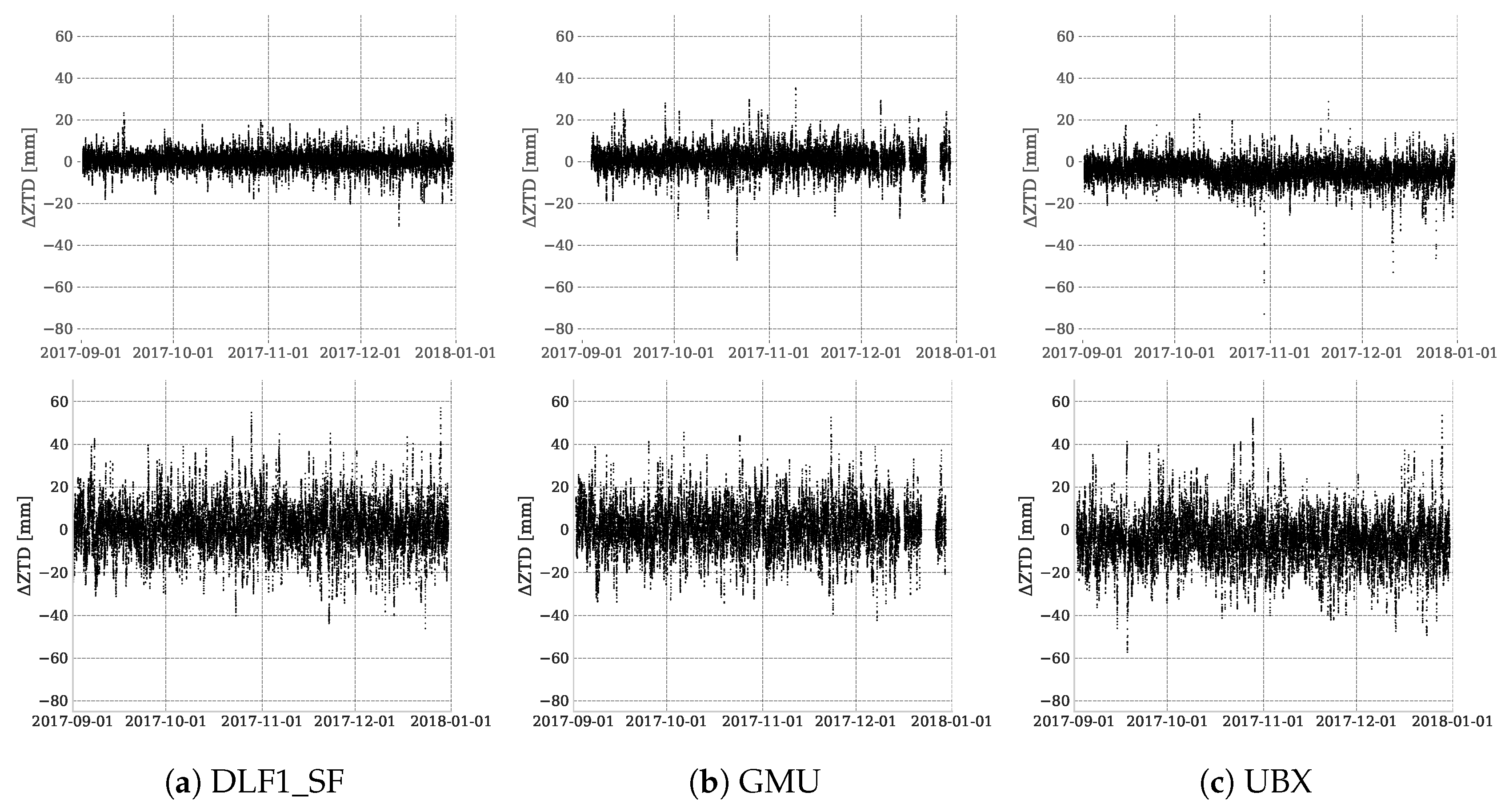
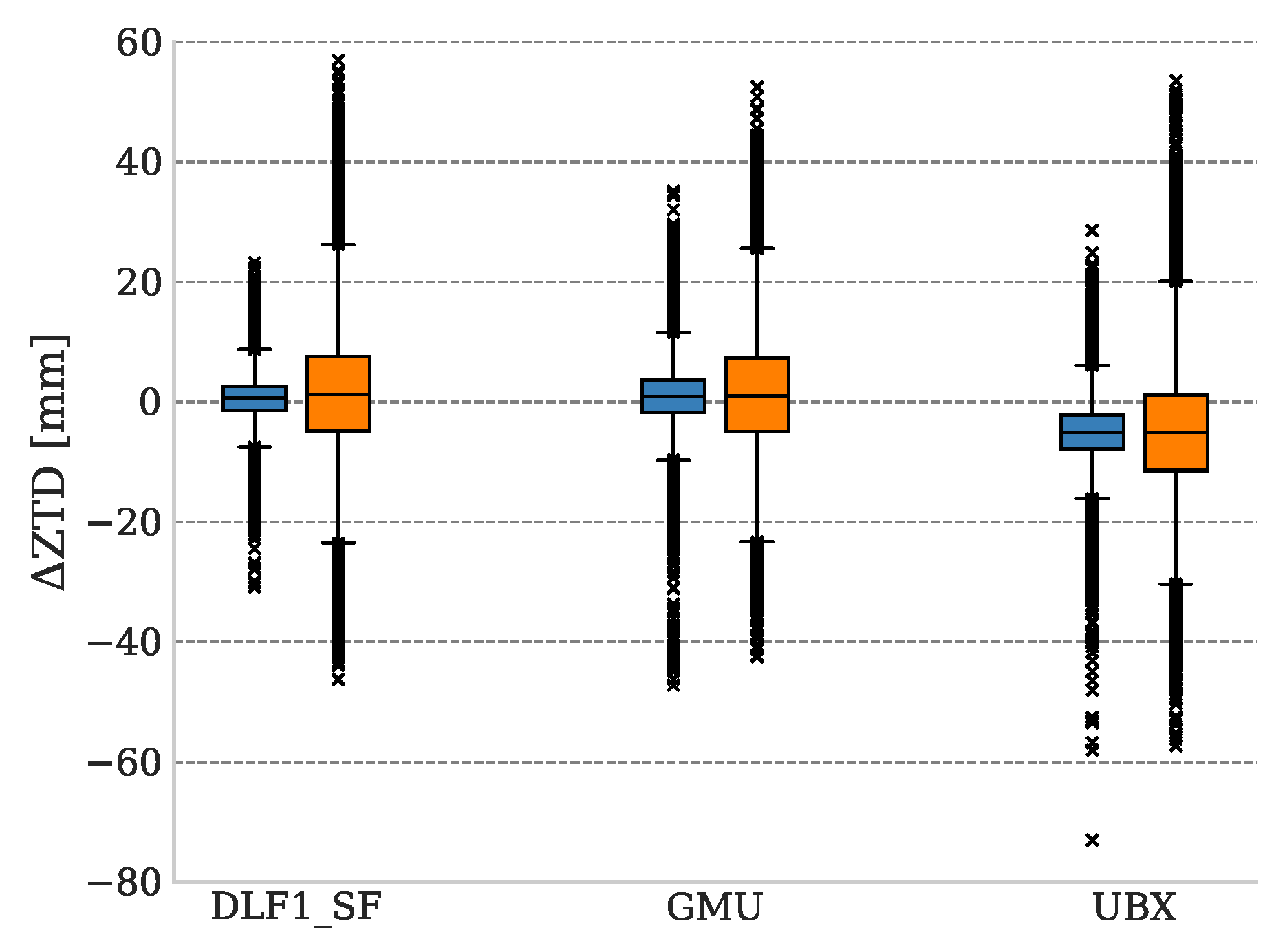



| Item | Processing Strategies |
|---|---|
| Software | goGPS v. 0.4.3 |
| Observations | GPS-only |
| Sampling interval | 30-second |
| Processing mode | SEID-PPP |
| Antenna calibration | IGS (if available) |
| Troposphere modeling | Saastamoinen (with GPT model) |
| Troposphere mapping function | GMF |
| Elevation cutoff | 10 |
| Ocean loading | FES2004 |
| Observation weighting | same weight for all observations |
| Clock & orbits | IGS Final |
| Kalman filter reset | no (seamless) |
| Code observation error threshold | 30 m |
| Phase observation error threshold | 0.05 m |
| Code least-squares estimation error st. dev. threshold | 40 m |
| AC | Processing Engine | Processing Method | Cutoff () | Resolution | Missing Days |
|---|---|---|---|---|---|
| IGS | Bernese 5.0 & 5.2 | PPP | 7 | 5 min | 10 |
| NGL | GIPSY/OASIS II | PPP | 7 | 5 min | 10 |
| BKG | Bernese 5.2 | Double-Differences | 3 | 60 min | 1 |
| LPT | Bernese 5.3 | Double-Differences | 3 | 60 min | 4 |
| ROB | Bernese 5.2 | Double-Differences | 3 | 60 min | 4 |
| Case | Site | RMSE [mm] | Bias [mm] | [mm] | Corr | %≥3 | %≥10 mm | %Missing |
|---|---|---|---|---|---|---|---|---|
| DPGA | DLF1_SF | 3.93 | 0.52 | 3.90 | 0.9967 | 1.64 | 2.61 | 0.46 |
| GMU | 5.55 | 0.99 | 5.46 | 0.9938 | 1.44 | 6.77 | 7.10 | |
| UBX | 7.10 | −4.96 | 5.08 | 0.9945 | 2.63 | 12.68 | 0.87 | |
| EUREF | DLF1_SF | 10.32 | −0.20 | 10.32 | 0.9769 | 0.92 | 29.04 | 0.28 |
| GMU | 10.20 | 1.11 | 10.14 | 0.9772 | 0.62 | 29.87 | 6.89 | |
| UBX | 12.09 | −4.93 | 11.04 | 0.9731 | 1.38 | 37.12 | 0.86 |
| Case | Site | RMSE [mm] | Bias [mm] | [mm] |
|---|---|---|---|---|
| SEID (DPGA) | DLF1_SF | 0.60 | 0.08 | 0.59 |
| GMU | 0.85 | 0.17 | 0.84 | |
| UBX | 1.05 | -0.72 | 0.77 | |
| SEID (EUREF) | DLF1_SF | 1.61 | -0.03 | 1.61 |
| GMU | 1.60 | 0.20 | 1.59 | |
| UBX | 1.86 | -0.70 | 1.72 |
© 2018 by the authors. Licensee MDPI, Basel, Switzerland. This article is an open access article distributed under the terms and conditions of the Creative Commons Attribution (CC BY) license (http://creativecommons.org/licenses/by/4.0/).
Share and Cite
Krietemeyer, A.; Ten Veldhuis, M.-c.; Van der Marel, H.; Realini, E.; Van de Giesen, N. Potential of Cost-Efficient Single Frequency GNSS Receivers for Water Vapor Monitoring. Remote Sens. 2018, 10, 1493. https://doi.org/10.3390/rs10091493
Krietemeyer A, Ten Veldhuis M-c, Van der Marel H, Realini E, Van de Giesen N. Potential of Cost-Efficient Single Frequency GNSS Receivers for Water Vapor Monitoring. Remote Sensing. 2018; 10(9):1493. https://doi.org/10.3390/rs10091493
Chicago/Turabian StyleKrietemeyer, Andreas, Marie-claire Ten Veldhuis, Hans Van der Marel, Eugenio Realini, and Nick Van de Giesen. 2018. "Potential of Cost-Efficient Single Frequency GNSS Receivers for Water Vapor Monitoring" Remote Sensing 10, no. 9: 1493. https://doi.org/10.3390/rs10091493
APA StyleKrietemeyer, A., Ten Veldhuis, M.-c., Van der Marel, H., Realini, E., & Van de Giesen, N. (2018). Potential of Cost-Efficient Single Frequency GNSS Receivers for Water Vapor Monitoring. Remote Sensing, 10(9), 1493. https://doi.org/10.3390/rs10091493






